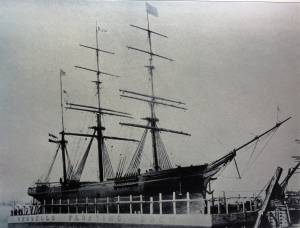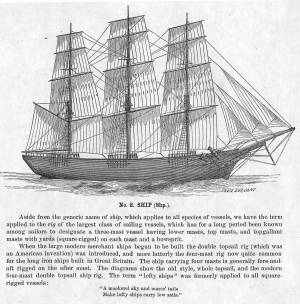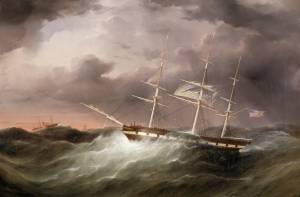An online project under the direction of the CAPE ANN MUSEUM
inv. 59
A Storm Breaking Away, Vessel Slipping Her Cable
1858 Oil on canvas 24 x 36 1/4 in. (61 x 92.1 cm) Signed and dated lower right: F.H. Lane 1858
Private collection
|
Related Work in the Catalog
Explore catalog entries by keywords view all keywords »
Historical Materials
Below is historical information related to the Lane work above. To see complete information on a subject on the Historical Materials page, click on the subject name (in bold and underlined).
The term "ship," as used by nineteenth-century merchants and seamen, referred to a large three-masted sailing vessel which was square-rigged on all three masts. (1) In that same period, sailing warships of the largest classes were also called ships, or more formally, ships of the line, their size qualifying them to engage the enemy in a line of battle. (2) In the second half of the nineteenth century, as sailing vessels were replaced by engine-powered vessels, the term ship was applied to any large vessel, regardless of propulsion or use. (3)
Ships were often further defined by their specialized uses or modifications, clipper ships and packet ships being the most noted examples. Built for speed, clipper ships were employed in carrying high-value or perishable goods over long distances. (4) Lane painted formal portraits of clipper ships for their owners, as well as generic examples for his port paintings. (5)
Packet ships were designed for carrying capacity which required some sacrifice in speed while still being able to make scheduled passages within a reasonable time frame between regular destinations. In the packet trade with European ports, mail, passengers, and bulk cargos such as cotton, textiles, and farm produce made the eastward passages. Mail, passengers (usually in much larger numbers), and finished wares were the usual cargos for return trips. (6) Lane depicted these vessels in portraits for their owners, and in his port scenes of Boston and New York Harbors.
Ships in specific trades were often identified by their cargos: salt ships which brought salt to Gloucester for curing dried fish; tea clippers in the China Trade; coffee ships in the West Indies and South American trades, and cotton ships bringing cotton to mills in New England or to European ports. Some trades were identified by the special destination of a ship’s regular voyages; hence Gloucester vessels in the trade with Surinam were identified as Surinam ships (or barks, or brigs, depending on their rigs). In Lane’s Gloucester Harbor scenes, there are likely (though not identifiable) examples of Surinam ships, but only the ship "California" in his depiction of the Burnham marine railway in Gloucester (see Three Master on the Gloucester Railways, 1857 (inv. 29)) is so identified. (7)
– Erik Ronnberg
References:
1. R[ichard)] H[enry] Dana, Jr., The Seaman’s Friend, 13th ed. (Boston: Thomas Groom & Co., 1873), p. 121 and Plate IV with captions.
2. A Naval Encyclopaedia (Philadelphia: L. R. Hamersly & Co., 1884), 739, 741.
3. M.H. Parry, et al., Aak to Zumbra: A Dictionary of the World’s Watercraft (Newport News, VA: The Mariners’ Museum, 2000), 536.
4. Howard I. Chapelle, The History of American Sailing Ships (New York: W.W. Norton & Co., 1935), 281–87.
5. Ibid.
6. Howard I. Chapelle, The National Watercraft Collection (Washington, DC: Smithsonian Institution, 1960), 26–30.
7. Alfred Mansfield Brooks, Gloucester Recollected: A Familiar History (Gloucester, MA: Peter Smith, 1974), 67–69.
Photograph
From American Clipper Ships 1833–1858, by Octavius T. Howe and Frederick C. Matthews, vol. 1 (Salem, MA: Marine Research Society, 1926).
Photo caption reads: "'Golden State' 1363 tons, built at New York, in 1852. From a photograph showing her in dock at Quebec in 1884."
Also filed under: "Golden State" (Clipper Ship) »
Oil on canvas
24 x 35 in.
Peabody Essex Museum, Salem, Mass.
Walters' painting depicts the "Nonantum" homeward bound for Boston from Liverpool in 1842. The paddle-steamer is one of the four Clyde-built Britannia-class vessels, of which one is visible crossing in the opposite direction.
View related Fitz Henry Lane catalog entries (2) »
Also filed under: Packet Shipping » // Walters, Samuel »
Provenance (Information known to date; research ongoing.)
Marks & Labels
Labels: (verso): [Pennsy]lvania Academy of t[he Fine A]rts / No. entered April 185[illeg.] / A Storm (break . . . Slipping her cable . . . / F.H. Lane / Depositor: J.S. Earle

_sm.jpg)





Commentary
Four years after painting A Rough Sea, 1854 (inv. 12), Lane revisited its theme of a ship anchored off a lee shore under adverse winds and tidal current. In this view, he portrayed a sequel and improving – but still dangerous – situation. Here the wind has shifted to an easterly direction (toward the rising sun) and tidal currents have begun to flow the same way, causing the ship to swing, stern to the sun. This requires careful tending of the anchor cable, keeping it taut while the ship is swinging, and finally slipping it (letting it go) with a marker buoy for future salvage.
This process is described in more detail by the essay in the section “Additional Material” below. Some details aloft are worth noting. The “housed” topgallant/royal masts in A Rough Sea, 1854 (inv. 12) have here been raised to their working heights. The associated standing rigging (stays and backstays) has been adjusted and set up taut, but square sails and yards will not be sent aloft until the ship is clear of danger and winds have subsided to warrant more sail. Present here, but not seen in the earlier painting are spreaders at the topgallant crosstrees for the topgallant and royal backstays. In depicting this detail, Lane unconsciously added an improvement to ships’ rigging that was widely adopted in the intervening years.
The logical “next scene” (if this painting and A Rough Sea, 1854 (inv. 12) were part of a series) would show the ship with two jibs set and drawing, her topsails unfurled and being set, and the anchor cable let go. While backing, the bow would swing counterclockwise to face the sun, the topsails would be sheeted in, and the ship would start heading eastward - just clearing the rock - into open ocean. Whether Lane planned (or actually painted) any sequel views is not known. Having already painted the two critical stages in this struggle to survive, he may well have decided that they were enough.
—Erik Ronnberg
[+] See More